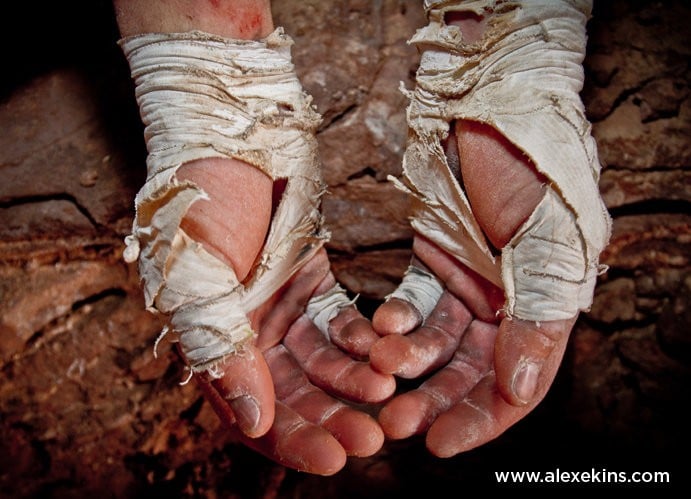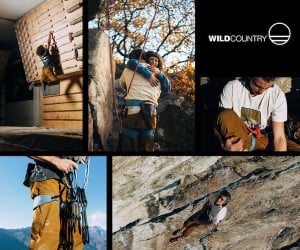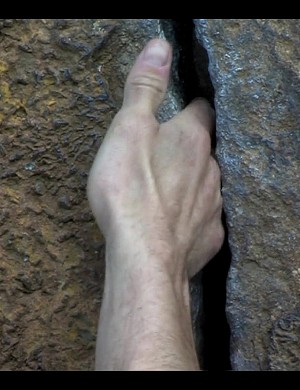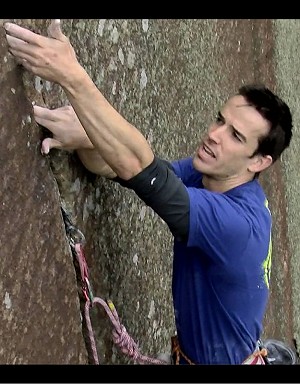Part 1 - Fingers
Tom Randall's Crack School Hints and Tips
Probably the most useful technique after the handjam, the finger 'jam' or 'lock' is based upon simply putting your fingers into a crack, or a constriction in a crack and pulling down until your fingers lock. At its most basic this is a simple, secure and very effective technique and the lock or jam becomes extremely good once you can place your confidence in it.
Unfortunately, it's not quite as comfortable as a jug and this technique does require an amount of pain resistance as it's the torquing or twisting action of the fingers in the crack which holds you in place. However, as your technique and your footwork improves, the potential pain should lessen as you pull less and climb more – a great reason to practice and learn!
One of the great things about the finger jam is that you will find lots of places to use it as it doesn't necessarily just appear simply as a long crack but in corners and grooves there is often a place to be able to jam your fingers to make a secure hold.
Techniques and Tips
Once you've got the basic idea of shoving your fingers in a crack and pulling down, feeling how the fingers 'lock' and how (as we show on the video) you will probably be relying on two fingers for grip as you swivel your hand, the most important thing to learn is whether to climb thumbs up or thumbs down. This is important because as soon as you are dealing with a crack which is not straight up (as well as some straight up ones) changing your hand around can be the secret to success, maintaining balance and keeping you relaxed.
In general you will probably climb 'thumbs down' in most situations and this does feel most secure on straight up finger cracks, but as they kink or turn, knowing when and how to switch hands is crucial to maintaining flow and balance.
Feet
As we demonstrate, there's also plenty of technique to placing your feet in thin cracks and once again it's wise to remember that, as in all climbing, the more weight you keep on your feet (and utilise the strength of your legs) the less you have to pull on your arms. And as we show, the basics once again involve finding either constrictions or overlaps: so either jamming your toes into pods or constrictions and crucially moving your knee upwards to get maximum rubber on the rock; or looking for overlaps, where you can apply a sideways frictional force – both of these allowing you to push up. Finally don't forget to look outside the crack for face holds, as on many easier and easier angled cracks these may be the key to success.
Overall, it's worth noting that the finger crack is possibly the most difficult crack to master foot technique on (especially when there's few face holds) and therefore the better you get the easier they will feel. Lastly, remember soft boots are generally better in these size cracks - both in terms of rubber surface area in contact with the rock and comfort.
Types of finger crack
It's also worth noting, that whether a finger crack is natural or manmade, it can make quite a difference to how you climb a crack. For example in a 'pegged' out' finger crack such as at Millstone in the UK or many of Yosemite's cracks, there will be more almost 'pocket like' constrictions where pegs have been, meaning that you must choose which to use. Testing and choosing can be slow but when you find the best one having a definite narrowing at the bottom can make these feel very secure On the flip side, natural cracks may have longer sections of a more equal width. Here it may be harder to find obvious constrictions (and unlike peg scars, no 'stop' to pull down on) but there is possibly more scope for simply shoving your hand in and pulling, which can be quicker.
Practice makes perfect
As always, the more you practice the better you get. If you can practice whilst stood on the ground this will make life a lot easier! Get plenty of trial and error in placing not only fingers but also feet and gear too. There's nothing worse than being halfway up a route you're desperate to on-sight and realise you've not learnt how to jam "thumbs up."





